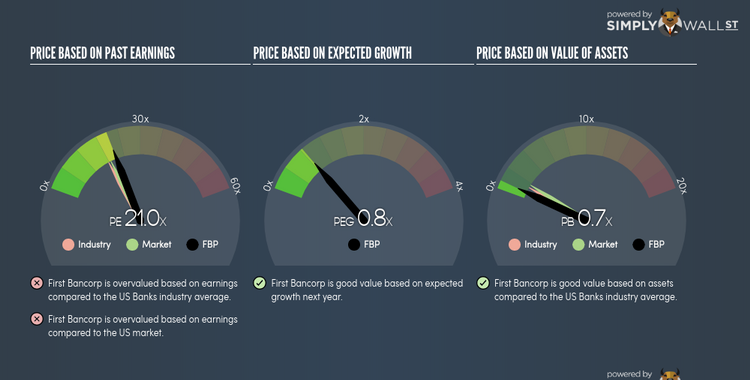Does First Bancorp’s (NYSE:FBP) PE Ratio Signal A Selling Opportunity?

First Bancorp (NYSE:FBP) trades with a trailing P/E of 21x, which is higher than the industry average of 17.8x. While FBP might seem like a stock to avoid or sell if you own it, it is important to understand the assumptions behind the P/E ratio before you make any investment decisions. Today, I will break down what the P/E ratio is, how to interpret it and what to watch out for. Check out our latest analysis for First Bancorp
Demystifying the P/E ratio
P/E is often used for relative valuation since earnings power is a chief driver of investment value. By comparing a stock’s price per share to its earnings per share, we are able to see how much investors are paying for each dollar of the company’s earnings.
P/E Calculation for FBP
Price-Earnings Ratio = Price per share ÷ Earnings per share
FBP Price-Earnings Ratio = $6.31 ÷ $0.3 = 21x
The P/E ratio isn’t a metric you view in isolation and only becomes useful when you compare it against other similar companies. Our goal is to compare the stock’s P/E ratio to the average of companies that have similar attributes to FBP, such as company lifetime and products sold. A common peer group is companies that exist in the same industry, which is what I use. FBP’s P/E of 21x is higher than its industry peers (17.8x), which implies that each dollar of FBP’s earnings is being overvalued by investors. As such, our analysis shows that FBP represents an over-priced stock.
A few caveats
While our conclusion might prompt you to sell your FBP shares immediately, there are two important assumptions you should be aware of. The first is that our “similar companies” are actually similar to FBP, or else the difference in P/E might be a result of other factors. For example, if you compared lower risk firms with FBP, then investors would naturally value it at a lower price since it is a riskier investment. The second assumption that must hold true is that the stocks we are comparing FBP to are fairly valued by the market. If this does not hold, there is a possibility that FBP’s P/E is lower because our peer group is overvalued by the market.
To help readers see pass the short term volatility of the financial market, we aim to bring you a long-term focused research analysis purely driven by fundamental data. Note that our analysis does not factor in the latest price sensitive company announcements.
The author is an independent contributor and at the time of publication had no position in the stocks mentioned.

